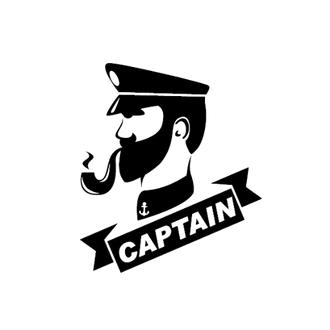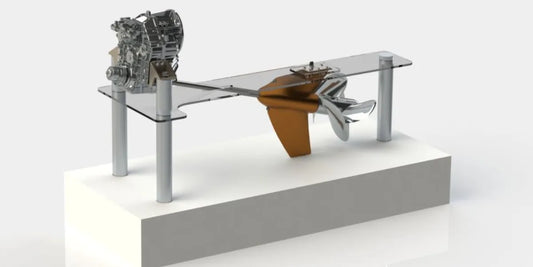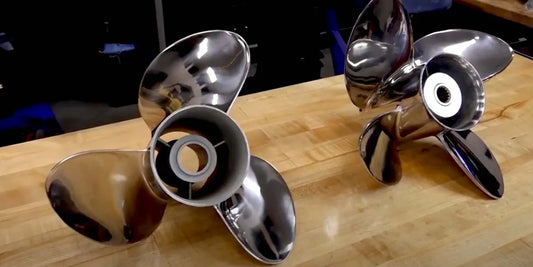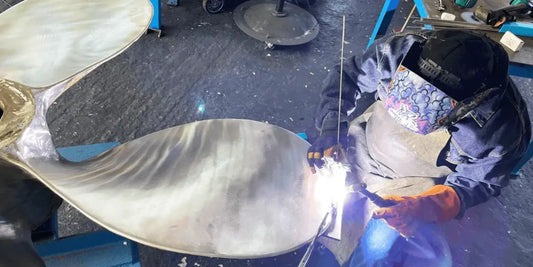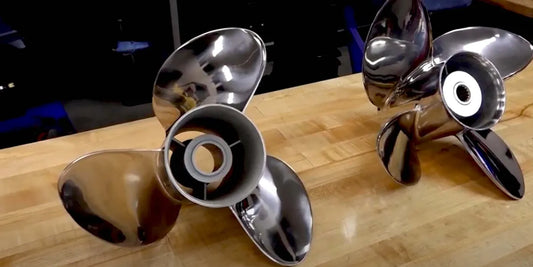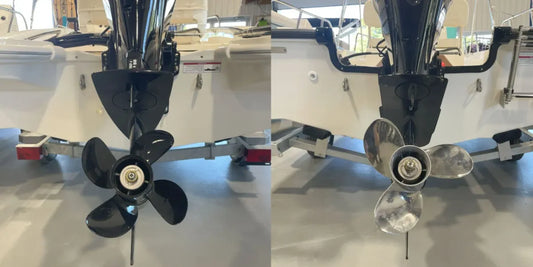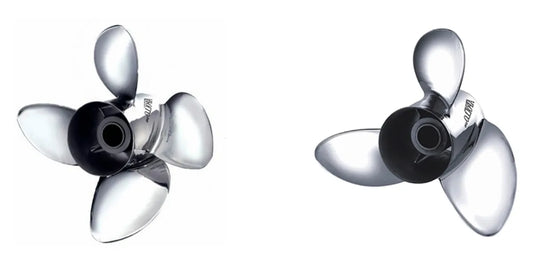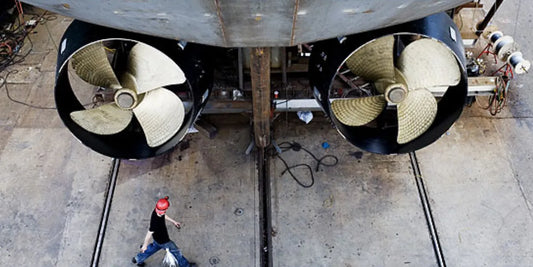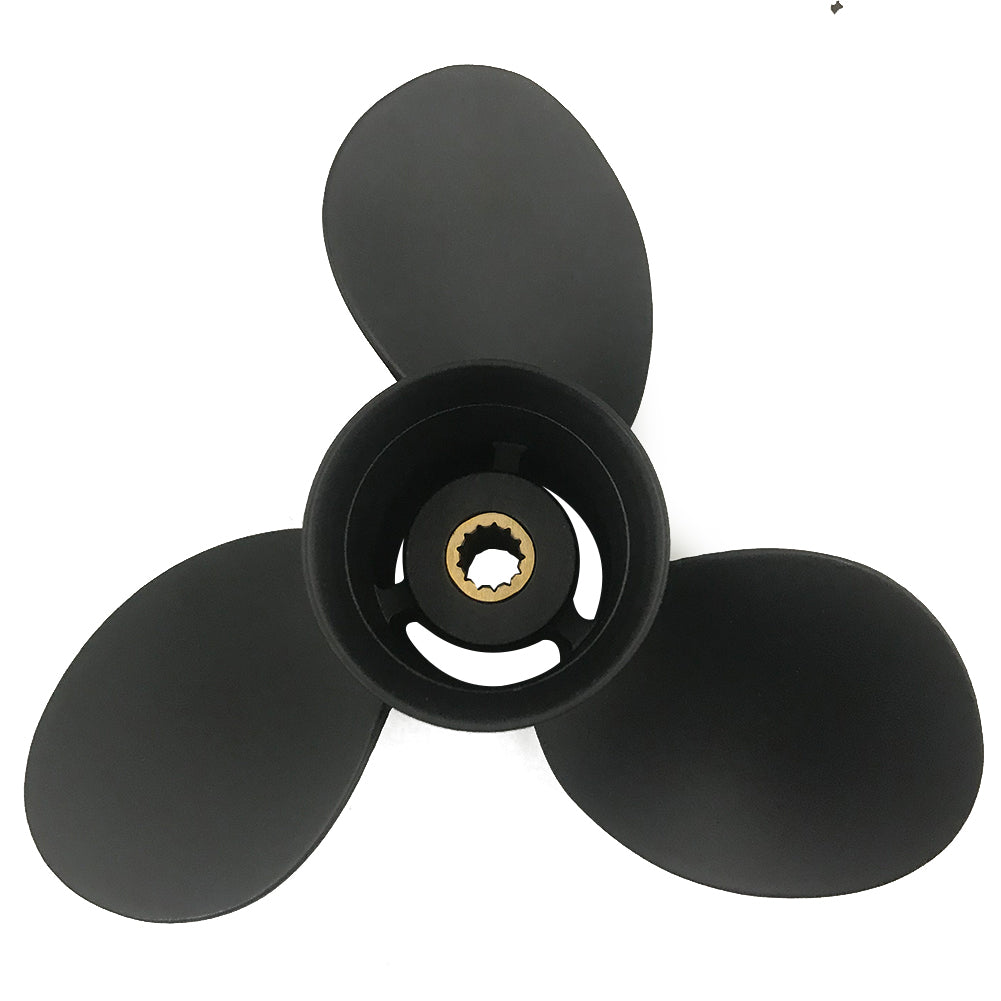In setting up an arrangement for peak marine and aviation applications, the propeller design is a necessity. Among the most common options to discuss are the 3-blade and 4-blade propellers, both of which have their own characteristics that affect efficiency, thrust, and maneuverability. So how do you know which configuration is right for you? This comprehensive comparative description aims to dispel the misunderstanding of the performance factors that distinguish the 3-blade propeller from the 4-blade propeller, highlighting their advantages and drawbacks, as well as cases where one might be preferred over the other. Whether it is for increased speed, improved fuel economy, or enhanced stability, this critical piece should help resolve your dilemma. For all those curious about what makes a propeller tick or how to tune their setup for the best performance, read on to learn about the key contributors to a propeller's performance.
Introduction to Propeller Types

What Is a Propeller with 3 Blades?
A 3-blade propeller, being one of the most common and versatile types, features three blades that are equally spaced around a central cup. Being efficient in smooth operation, it finds applications in boats, planes, drones, and other similar vehicles. From the design point of view, a 3-blade propeller is a compromise of performance and maneuverability. Thus, it is a choice favored by users seeking dependable and stable performance in varying operating situations.
With the 3-blade propeller setup, there is a bigger thrust generation compared to the two-blade setup, but the aerodynamic noise is relatively low. In the force generation process, three blades produce a smoother-induced force with less pulsation, which reduces strain on the engine or motor, resulting in improved fuel or energy efficiency. In this way, the configuration is favorable for conditions that require extended operation, such as recreational boating or commercial aviation, where comfort and fuel economy are essential.
Another reason why the three-blade propeller configuration may be considered better up to a point is that it is preferred in situations where acceleration and load-carrying capabilities are essential. With its somewhat smaller diameter, a 3-bladed propeller, compared to those with 4, 5, or 6, experiences less drag and achieves an excellent compromise between high speed and stability. As with anything, it comes with its negatives; chiefly among them is having less maximum thrust than 4- and 5-blade propellers under maximum load conditions. Rap the performance and efficiency demands against the properties of a 3-blade propeller and match accordingly.
What is a 4-Blade Propeller?
A four-blade propeller is usually selected when better plane balance is sought or when thrust is subjected to severe conditions, and smooth operation is necessary. Regarding 3-blade designs, 4-blade propellers typically produce more thrust, especially at low speeds, making them ideal for heavier vessels or situations where precise maneuvering is required. Additionally, an increased blade surface generally means reduced vibration, providing a quiet and comfortable working experience.
Sometimes, 4-blade propellers, which offer increased stability and thrust, may lack top speed when pitted against 3-blade propellers due to the very drag that inhibits their efficiency at the highest speeds. Expense-wise, they are more costly than their counterparts due to the additional raw materials and manufacturing time required for their production. Hence, deciding on a 4-blade propeller could involve considering the vessel's weight, the engine's power, the intended use, and all performance aspects that contribute to its ultimate efficiency and effectiveness.
Key Differences Between 3-Blade and 4-Blade Propellers
However, when comparing 3-blade with 4-blade propellers, many crucial differences come into play to affect performance and suitability for particular jobs. Since a 3-blade propeller is lightweight and straightforward, it has the advantage of less drag and higher speeds. Thus, this type gives the most incredible speed for small boats and is considered best when speed is paramount. The 3-blade type is also more fuel-efficient when the highest speed is maintained, and is therefore cheaper due to the small amount of material used and the ease of manufacture involved.
On the contrary, four-blade propellers will be preferable for applications that require enhanced stability and smoother handling. They offer more thrust and grip in the water, especially at low speeds, making them suitable for heavier vessels or those that navigate through rough waters. Lessening vibration translates to an improved ride and better steering control. These four-blade propellers will provide superior towing capabilities, ideal for water sports activities or commercial situations where constant power is required under heavy loads.
In the decision-making process between choosing a 3-blade and a 4-blade propeller, consideration is given to the average requirements relative to the vessel's speed, which determines the size and use thereof. Observations from interpreting data stimulate further research on the importance of propellers in matching engine characteristics and conditions for maximum efficiency, longevity, and performance.
Performance Analysis of 3-Blade vs 4-Blade Propellers

Speed and Efficiency of a 3-Blade Propeller
At higher speeds, this propeller is highly efficient and, therefore, a favorite of speed-oriented watercraft such as performance boats and smaller recreational vessels. Being streamlined in form, it causes less drag, allowing the engine to operate at maximum efficiency and produce thrust and grooming agility. Due to their relative lightness, three-blade propellers place less stress on the engine, and engineers claim that this can lead to improved fuel economy, which is particularly crucial for long journeys or vessels where operating costs are a priority. Additionally, the lower surface area of the blades causes less resistance to water, allowing the boat to maintain a higher velocity as it moves against the currents.
With an analytical approach, one learns that 3-blade propellers can outperform 4-bladers, primarily because they draw less resistance from calm to moderately choppy waters. Vessels attempting to achieve maximum speed while maintaining reasonable fuel consumption are, therefore, striking a balance between performance and operational cost. While the 3-blade propellers can bring another spin of speed and economic power, they can introduce instability at lower speeds or in rougher conditions, where there is a greater emphasis on speed over precision handling.
High speed and outstanding efficiency of the 4-blade propellers
I generally prefer the 4-blade propeller when stability and smooth operation are required, especially in rough water conditions. The additional blade, compared to the 3-blade type, possesses a greater gripping ability, which assists in better hands-on control, allowing for faster acceleration and steadier cruising at lower speeds. Hence, these boats either run in choppy waters or require a lot of torque, looking for towing or heavy-lifting operations.
While 4-blade propellers may sacrifice a bit of top-end speed compared to 3-blade varieties, they do stand out when it comes to maintaining efficiency under load and during extended-duration operations. Moreover, their design also reduces susceptibility to cavitation, resulting in smooth cruising and improved fuel efficiency when combined with state-of-the-art materials and precision-crafting techniques. Furthermore, studies have shown that by optimizing blade shape and pitch, 4-blade propellers could almost rival the top-speed capacity of 3-blade propellers, with extra stability being of immense value for many applications.
Comparing Performance Characteristics: 3-blade versus 4-blade
When examining the performance characteristics of 3-blade versus 4-blade propellers, all pivotal factors, such as speed, acceleration, fuel economy, and general handling, take precedence.
Speed: 3-blade propellers are pretty much known for the highest-end-of-the-scale top-end-speed generation. Third-blade propellers are lighter in weight and, hence, they create less drag at higher RPMs and, therefore, are the best applications where speed matters most. Conversely, 4-blade propellers are slightly slower in their top-end speed but provide consistent thrust and power from engine to water, which may be beneficial in rough waters or when towing.
Acceleration and Thrust: Due to the extra blade, 4-blade propellers offer faster acceleration and more efficient mid-range thrust. This makes things particularly beneficial for water sports, where a quick response is crucial. With a good grip on the water, this also leads to smoother control and greater stability in rough waters.
Fuel Efficiency: When compared to 4-blade propellers, three-blade propellers can achieve better fuel efficiency at cruising speeds due to their reduced drag and greater streamlining. However, new developments in the design of 4-blade propellers have largely limited such a difference in fuel efficiency, especially in scenarios requiring consistent heavy loads. Blade pitch and material technology represent other factors that affect fuel consumption and efficiency, as well as the relative performance of one over the other.
Handling and stability: The primary advantages of 4-blade propellers lie in their improved handling and stability at low speeds, resulting in a steadier ride in rough waters and reduced vibration, which ensures better control. Conversely, 3-blade designs feel less stable at slow speeds and contribute even more vibration to the craft, though they maintain excellent responsiveness at higher speeds.
Modern propeller technology continues to innovate, reducing performance differences and providing buyers with the flexibility to select a blade configuration option that best suits their needs. By adjusting design parameters such as rake, pitch, and diameter, both 3-blade and 4-blade propellers can be very specifically tuned for an infinite number of applications.
Impact of Propeller Design on Boat Handling

Impact of 3-Blade Propellers on Maneuverability
Three-blade propellers enjoy a reputation for being efficient and versatile for a wide array of marine applications. Their design aims to strike a balance between speed, thrust, and fuel economy. The propeller with fewer blade surface areas causes less drag; hence, it permits better top-end speed and nanosecond acceleration. With less wedge and streamlined efficiency, 3-bladers better handle across the lower loads and, therefore, are primarily used in recreational and high-speed performance applications.
3-blade propellers tend to work better in applications where very smooth rotation is required, generating low turbulence within calm waters. This results in the stabilization of fast maneuvers that require quick directional shifts or adjustments. Yet, under high-current conditions or with heavy vessels, the control precision might be downgraded since the grip is lower than with a 4-blade prop. Given a good study of pitch and rake and their selection for working conditions, 3-blade propellers can provide the user with high advantages, such as speed and maneuverability, without any compromise on fuel range.
How 4-Blade Propellers Improve Stability
If riders are going to be performing the appropriate maneuvers, such as steep turns and rapid crossings of waves, 4-blade propellers provide the necessary stability and control for the job. These types of propellers have an increased surface area, producing more lift in the water, which ultimately improves the handling and control of the craft.
It will all matter in strong currents and choppy waters, or when carrying heavy loads. The 4-blade propeller can provide significantly less vibration, improved comfort, and reduced stress on vital vessel components. They may also be providing more thrust at low speeds, making them preferable for trolling or precise maneuvering. While the top-end speed is somewhat suppressed compared to the 3-blade variant, you know well that stability and effective power utilization are well worth it.
Modern propeller technology advancements, such as blade geometry optimization and the use of sturdy materials, enhance the advantages of 4-blade configurations, resulting in improved durability, fuel savings, and flexibility across diverse environments. This makes it a trustworthy choice for control and performance-oriented individuals in changing conditions.
Choosing the 4-Blade Right Propeller for Your Boat
Once you have decided on the perfect 4-blade propeller, it is essential to check key fundamental aspects to optimize your boat's performance and working conditions. Pitch is a significant factor in propeller consideration as it controls speed and thrust efficiency. A lower pitch offers more control and acceleration that suits speed boat activities (water sports), while a higher pitch suits maximum speed. Besides pitch, diameter is crucial for propulsion and handling capacity, especially in the case of big boats or heavy loads.
Another crucial aspect relates to the composition of the propeller. In the respect of ultimate wear resistance, stainless steel propellers are best-suited for harsh conditions. In contrast, aluminum propellers offer an inexpensive alternative in less critical applications. Depending on the specified design, the engine and propeller should be matched accordingly with the horsepower of your boat to work at maximum efficiency and prevent damaging the motor.
Likewise, boaters should weigh the typical nature of their waters. To exemplify, enhanced durability may be required as a feature of a propeller in shallow water bodies with numerous potential impacts from debris; hence, its counterpart, deep calm water, offers more options for choice. Factoring in variables, however, can enhance the pick in synergy with fuel efficiency, handling, and overall enjoyment.
Fuel Economy and Cost Considerations

Fuel Efficiency of 3-Blade Propellers
3-blade propellers strike a reasonable balance between power and fuel efficiency. The thrust-to-speed ratio is ideal for various boat usage scenarios. More drag is developed in 4- or 5-blade types; hence, a 3-blade propeller would improve the fuel consumption of a craft at least at higher speeds.
For recreational use, these props are highly favored, offering a smooth performance without placing maximum stress on the power engine. For example, it has been demonstrated that 3-blade propellers on boats can cruise at slower speeds, using less horsepower and, consequently, saving fuel over a longer trip. Lately, advances in materials and manufacturing techniques, such as light and hydrodynamic design, have significantly enhanced the fuel-saving capabilities of propellers. By minimizing energy wastage on the 3-blade propellers and utilizing the maximum potential for propulsion, this option remains the most economical for the boater concerned with fuel efficiency.
Fuel efficiency of 4-blade propellers
Four-blade propellers are designed for fuel efficiency and handling; the extra blade produces better grip for boats operating under heavy load or in waters under challenging conditions. A four-bladed design results in less slippage, a larger surface area, and better grip in water. This compensates for the slight increase in fuel consumption by lending smoother and more balanced operations at various speeds.
Recent developments indicate that at lower RPMs, a four-blade propeller may even offer better fuel economy than a three-blade propeller. Data analysis suggests that these propellers perform well for vessels requiring constant thrust or operating in choppy waters. The even distribution of power from the engine reduces stress, allowing for optimal energy use during long-haul trips.
Boats with 4-blade propellers are better suited for towing applications and rough sea conditions, where maintaining stable speeds is crucial. Their operation results in a marginal sacrifice of speed for better long-term cost benefits, owing to reduced stress on the engine and lower fuel consumption in specific applications. Exploiting these appears to be the best choice for applications requiring steady performance and reliability.
Price Implication of 3-Blade Versus 4-Blade Propellers
In analyzing the price implications of 3-blade versus 4-blade propellers, it is essential to evaluate upfront costs against long-term value. In general, 3-blade propellers are less expensive to purchase due to their simple construction and fewer materials required. They are used more for recreational purposes and other instances where high-speed performance is the principal consideration, presenting an advantage to the boat owner for lightweight usage.
Conversely, 4-blade propellers typically incur higher initial costs due to their added complexity and enhanced performance characteristics. Usually, that extra expense is worth it in specific applications, such as towing, rough-water work, or workboats that require relatively consistent power under varying loads. Smooth running underwater better protects the engine from strain and thus may also help with fuel savings.
There is a difference in maintenance cost depending on usage. 3-blade props may be subject to faster wear and tear when subjected to heavy work, consequently incurring costs to replace them, whereas 4-blade sets are presumably more durable under these more rigorous tests. Ultimately, selecting the right propeller requires consideration of its initial cost, expected service life, and efficiency benefits about the vessel's operational needs and budgetary constraints.
Real-World Applications and User Experiences

Case Studies: Boats Using 3-Blade Propellers
Generally speaking, my experience has shown that three-blade propellers offer a nice compromise between efficiency and performance for various boats. One such instance was a mid-sized fishing boat that I helped equip. The owner wanted a propeller that could provide good thrust while also being economical with fuel on these longer trips. After the switch to the high-grade three-blade propeller, she accelerated well and achieved a good speed range in the mid-range area, all while reducing fuel consumption compared to the formerly installed four-blade arrangement. The gain in fuel efficiency was highly valued in offshore fishing areas, where reliability and range were primary considerations.
Another example entails such a recreational speedboat where a higher top-end speed was preferred. The 3-blade propeller set was ideal because it was designed with speed and agility in mind. The boat owner immediately reported better responsiveness and overall handling, especially when making sharp turns or racing across open water. The propeller performs well enough when moderately loaded, but not at its maximum stress limit, and it maintains its durability under these conditions. Such firsthand experiences demonstrate that 3-blade propellers, in the proper application, can be a viable alternative in terms of efficiency and speed.
Case Studies: Boats Using 4-Blade Propellers
From what I have witnessed, switching to a 4-blade propeller made my boat more versatile overall. The biggest thing that came to mind was maybe the low-speed handling and control. Docking and tight-space maneuvers became much more straightforward and precise, which was a significant advantage in crowded marina conditions. The extra blade provides a better grip in the water, which smoothens the ride and offers good stability, even in rough water.
Acceleration was another significant advantage I observed after fitting almost any 4-blade propellers. My boat was able to get onto a plane faster, even when carrying heavier loads. These served well on family and friends' recreational outings, so that being able to tube and wakeboard was never compromised. Again, at cruising speed, it remains the best in terms of thrust and cruising efficiency over long distances.
In general, performance and versatility are well balanced on this 4-blade propeller. At pace, whether trying to maintain control at slower speeds or chasing maximum excitability for recreational activities, the high-performance prop is indeed reliable in any scenario. For anyone considering a solution that combines handling and power, a 4-blade prop is worth a look.
User Reviews: Preferences and Performance Insights
Based on my observations, most users prefer a 4-blade propeller due to its improved handling, balance, and performance. I found it provided the smoothest acceleration and best control, which is crucial for activities such as wakeboarding, where stability matters more than anything else. Essentially, user reviews suggest that 4-blades are highly favorable for mid-range performance and maintaining a steady speed, which benefits the casual boating experience for those who depend on assured reliability.
Another feature that has been widely debated is fuel efficiency during long trips. I discovered a few gains in fuel economy to add to the long list of practical cruising options without walloping performance. In this regard, the robustness of the propeller design was a plus, considering it took all kinds of water condition changes while minimizing cavitation; this turned out to be useful for most operators (including myself) in really challenging water environments. The bottom line: power and finesse lie well balanced in a 4-blade propeller, thereby making it suitable for a myriad of boat uses. This upgrade has earned the recommendation of most users and me among those looking to enrich an overall boating experience.
Reference Sources
-
3 Blade vs. 4 Blade Propeller - Michigan Wheel
Discusses the performance differences, including drag, horsepower, and efficiency. -
4 Blade vs 3 Blade Propeller - The Hull Truth
Explores how 4-blade propellers perform better at low speeds and their trade-offs in efficiency. -
What's the Difference Between 2, 3, and 4-Bladed Propellers? - Airplane Academy
Provides insights into the advantages and disadvantages of different blade counts, including 3- and 4-blade options. -
3 Blade vs 4 Blade Opinions - Microskiff
Shares practical opinions and experiences comparing 3-blade and 4-blade propellers for various applications.
Frequently Asked Questions (FAQs)
What are the main differences between a 3-blade prop and a 4-blade prop?
The primary differences between a 3-blade propeller and a 4-blade propeller are that the three-bladed prop will produce less drag and, hence, allow for better top-end RPM. On the contrary, a 4-blade prop will offer the best hole shot and acceleration, which is helpful for ski boats, for example, with quick starts. The blade area also increases with a 4-blade prop, which has the benefit of improved fuel efficiency at lower RPMs. Ultimately, it comes down to the application of the boat when determining what should be chosen between a 3-and 4-blade prop.
Which is better for fuel efficiency, a 3-blade or a 4-blade prop?
Fuel efficiency is influenced by the prop design and AWTs. Generally speaking, a 4-blade prop provides better fuel efficiency at cruise speeds owing to the greater blade surface area, which creates more thrust at lower RPM. This means that, if you choose to run your boat at lower rpm, the 4-blade prop will be able to help you maintain your speed very effectively and with less strain on the engine. On the other hand, if you want to go faster, then the 3-blade should give higher efficiency at those speeds. To eliminate the guesswork of determining the most fuel-efficient propeller, consider the pitch prop in conjunction with the specific performance requirements of your boat.
How does the blade count affect a prop's performance?
Very much so! The number of blades determines how a prop performs. Fewer blades in a three-blade prop translate to less drag, hence the possibility of attaining higher top-end speed, which is where all the demand lies for racing or any other high-speed applications. The four blades will give more thrust and stability. Hence, it will provide a better hole shot and acceleration. The increased blade area in those four blades also helps them share the working load more effectively, thereby reducing prop slip and enhancing handling in slapping conditions. Most boaters have to choose between speed and acceleration on whether they go with a three-or four-blade prop.
Will a 4-blade prop give my boat a better hole shot?
The hole shot in any boat is said to be enhanced by a 4-blade propeller. The extra blade provides a higher surface area for thrust, allowing the ship to accelerate from a standstill position. This aspect is predominantly desirable in ski boats where quick acceleration is paramount for towage. While the 3-blade prop may excel in speed, the 4-blade prop offers significantly better performance at low speeds and helps the plane take off much faster. Large loads and frequent quick starts are two situations in which a 4-blade prop would come in quite handy.
What is the effect of pitch on propellers having three versus four blades?
Hold-down pitch acts as a prop, influencing potential quality decisions, and speed and acceleration are affected accordingly. For both 3-blade and 4-blade props, by increasing pitch, the top speed also increases, although it might have a sluggish effect on acceleration and hole shot. A lower pitch would help the hole shot but limit the top speed. When comparing a 3-blade propeller with a 4-blade propeller, pitch must be selected with great care, depending on the engine RPM at which the boat will be operating and for its primary purpose. You can make the boat go faster by adjusting the pitch or by improving its hole shot; according to which you choose to prioritize, pitch adjustment can cast its vote either way.
Is a 3-blade prop or a 4-blade prop better for rough-water conditions?
A 4-blade prop is generally preferred also in rough water, due to the increased blade area and thrust. An extra blade enhances the boat's control and stability in rough waters by producing a steadier thrust through the water, resulting in a smoother ride and improved handling, especially at lower speeds. A three-blade prop might lose its grip or ventilate in an aggressive environment, something a four-blade prop can help alleviate. Hence, a 4-blade prop would be able to increase the general performance and safety for any captain facing rough waters frequently.
